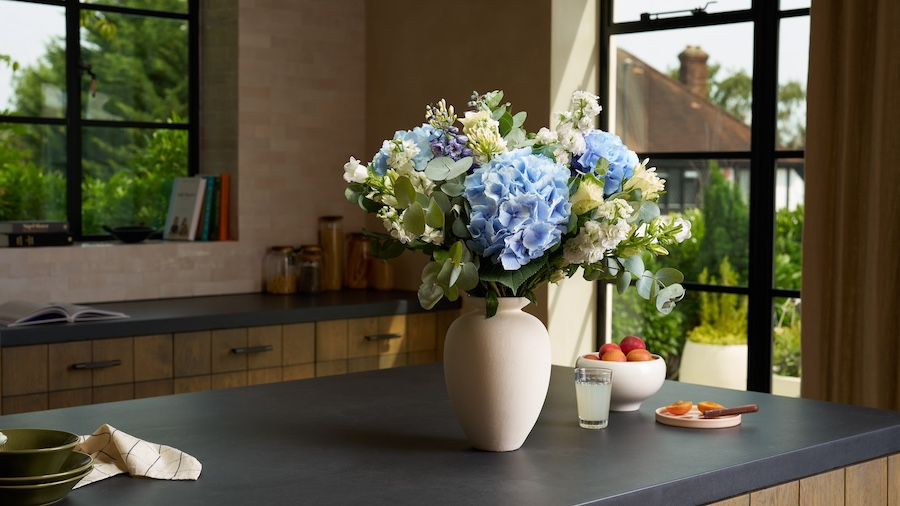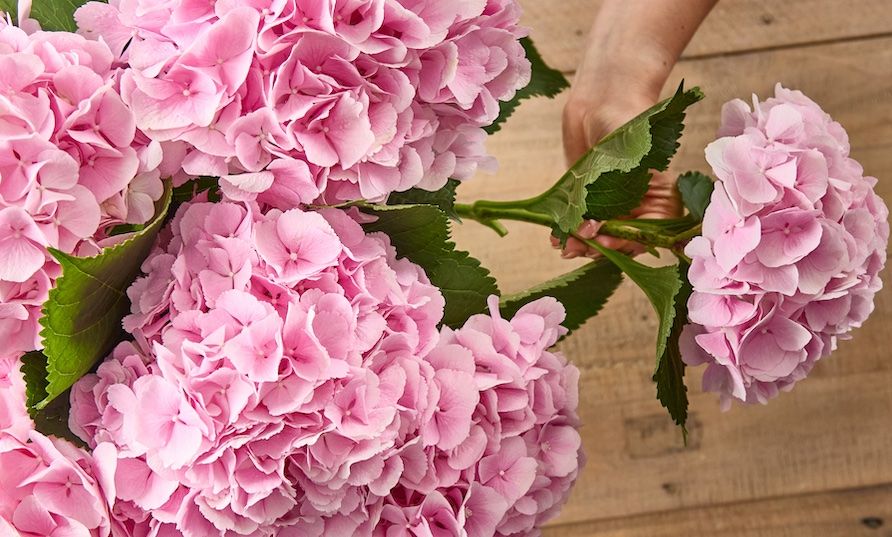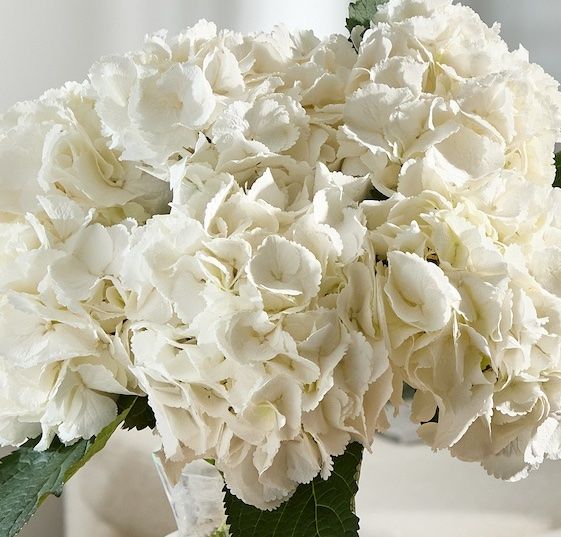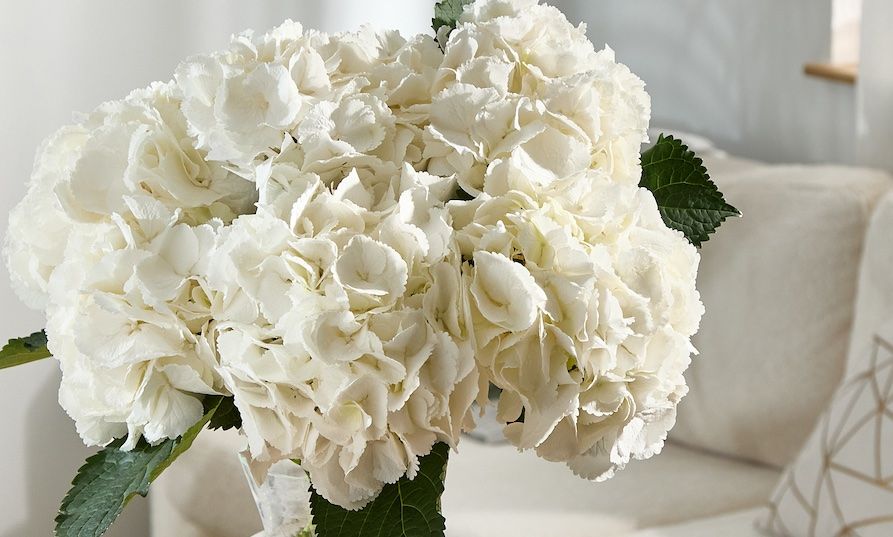A complete guide to hydrangeas: symbolism and care tips


Whether blooming from a garden shrub or displayed in an elegant vase, hydrangeas (pronounced hi-drain-gee-uhs) are truly captivating. Their big, bold flowerheads, made of myriad petals, are all the more inspiring thanks to their striking shades, which range from elegant cream to the deepest, darkest purple. Hydrangeas bloom during Summer in the UK, with different varieties blossoming at different times.
The most popular hydrangea varieties
There are more than 70 species of hydrangea, which are native to Asia, North America and the Himalayas. Though each flower is distinctive in their own right, they each have the big, multi-petaled flowerheads that are characteristic of this beautiful bloom. Here are a few of the most popular hydrangeas.Also known as bigleaf hydrangeas due to their large foliage, hydrangea macrophylla is a group of three flower varieties: mophead, lacecap and mountain hydrangeas. Mophead hydrangeas are the variety you’ll most likely found in bouquets, and have large petals that cluster together to form a big round flowerhead. Lacecaps are the same shape but are made up of smaller buds in the centre and larger buds on the exterior. Mountain hydrangeas are similar to lacecaps, but their leaves have a serrated edge.
Also known as panicled hydrangeas, these flowers have dense clusters of pink or white flowers that grow in a cone shape.
Commonly known as smooth hydrangeas, these dense flower buds are similar to mophead hydrangeas in shape, but they have smaller petals that grow in tight clusters. They are typically white in colour.
Hydrangea quercifolia are also known as oakleaf hydrangeas thanks to the shape of their leaves. These flowers feature large petals and grow in cone-shaped clusters. In Autumn, they can be a beautiful red hue.


What is the meaning behind gifting hydrangeas?
Hydrangeas have a variety of connotations, some more positive than others. Historically they’ve symbolised heartfelt emotion and gratitude in Japan, while in Europe they’ve been considered to represent arrogance and vanity. In the modern day, hydrangeas are seen more positively and are often used in wedding bouquets or as anniversary gift, with different coloured hydrangeas representing different meanings.- Pink hydrangeas
These powder pink blooms are as sweet as the message they hold. They symbolise love and sincere emotions, and are sometimes compared to a beating heart. - Blue hydrangeas
For those looking for forgiveness, look no further than the blue hydrangea. These blooms also represent regret, making them a good place to begin when making an apology. - White hydrangeas
Purity and grace are the words that spring to mind when thinking of white flowers, and the elegant hydrangea is no exception. These blooms make for beautiful additions to wedding bouquets. - Purple hydrangeas
Like many purple flowers, these rich-coloured hydrangeas symbolise royalty, wealth and abundance. They’re a luxurious gift for a loved one who deserves to be treated well. - Green hydrangeas
Fresh and verdant, green hydrangeas are considered a symbol of good fortune, prosperity and youthfulness. They’re the perfect gift for someone making a fresh start, such as a new job or a new home.
How to keep hydrangeas fresher for longer
How long do cut hydrangeas last? With the right care, your beautiful blooms can live for up to two weeks. The name hydrangea comes from the Greek words for water and pitcher, which gives a good idea of how to care for these blooms – they need plenty of water, so keep them hydrated to help them last as long as possible. For advice on how to look after hydrangeas, read on.1. When you first receive your hydrangeas, trim the stems at a diagonal slant and remove any lower leaves that may dip into the water. This will extend the vase life of hydrangeas by preventing any harmful bacteria from growing on your stems.
2. Select a vase with a wide opening to allow air to flow through, and clean it well before filling it with fresh water. Add any flower food your stems may have arrived with, and place your hydrangeas in the vase.
3. Hydrangea care is all about ensuring your stems receive enough water, so be sure to refill your vase every couple of days. This will not only keep your flowers hydrated, but will prevent harmful bacteria from building up.


The best places to keep hydrangeas
Both hydrangea cut flowers and growing hydrangeas do not like full sun, and so your bouquet will much prefer a cool, shady spot in your house. If you’re wondering how to keep your hydrangeas from wilting, then be sure to select a space away from direct sunlight and humid temperatures.How to perk up hydrangeas
If your flowers are staring to wilt, you may be able to revive them using this remedy.1. Submerge the entire flower in a “bath” of shallow water for 15-20 minutes. Make sure the blooms are fully submerged – if they float, place a light weight on top to keep them underwater. Soaking your hydrangeas allows them to rehydrate through both the stems and petals.
2. Next, trim the stems again with clean secateurs and dip the cut ends into boiling water for a few seconds. This helps to dissolve any sap that may be blocking the stems.
3. Before you arrange your stems back in their vase, clean it well and fill it with lukewarm water – this is more easily absorbed than cold water and will help your stems stay hydrated.
Are hydrangeas pet friendly?
Sadly, hydrangeas are poisonous for dogs and cats, so we recommend keeping your flowers out of reach from furry friends, or in a room that they rarely go into. If you’re looking for non-toxic flowers, why not explore ourpet-friendly range instead?If you have your heart set on hydrangeas, you can explore our hydrangea collection during Summer, or discover the other beautiful flowers in our collection all year round.